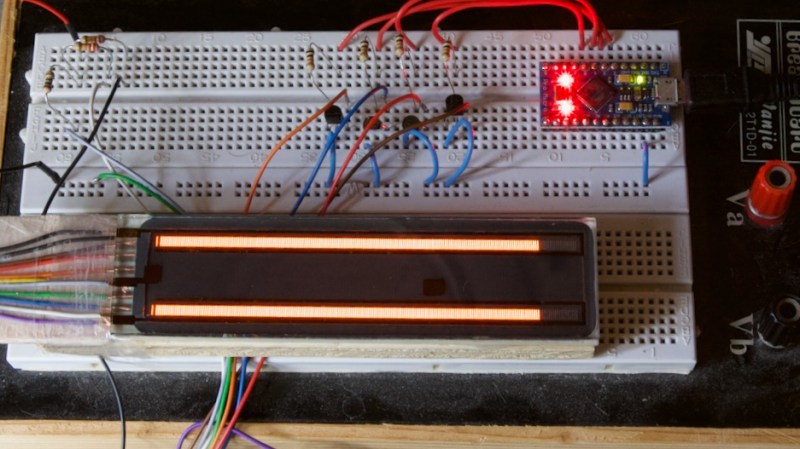In the days before every piece of equipment was an internet-connected box with an OLED display, engineers had to be a bit more creative with how they chose to communicate information to the user. Indicator lights, analog meters, and even Nixie tubes are just a few of the many methods employed, and are still in use today. There are, however, some more obscure (and arguably way cooler) indicators that have been lost to time.
[Aart Schipper] unearthed one such device while rummaging around in his father’s shed: a pair of Burroughs Bar Graph Glow-Transfer Displays. These marvelous glowing rectangles each have two bars (think the left and right signals on an audio meter, which is incidentally what they were often used for), each with 201 neon segments. Why 201, you may ask? The first segment on each bar is always illuminated, acting as a “pilot light” of sorts. This leaves 200 controllable segments per channel. Each segment is used to “ignite” its neighboring segment, something the manufacturer refers to as the “Glow-Transfer Principle.” By clever use of a three-phase clock and some comparators, each bar is controlled by one analog signal, keeping the wire count reasonably low.
Don’t get us wrong, the warm, comforting glow of Nixie tubes will always have a special place in our hearts, but neon bar graphs are just hard to beat. The two do have a similar aesthetic though, so here’s hoping we see them used together in a project soon.
Thanks to [Jan] for the tip!















No video of it in action, no one cares.
Roger Roger.
What’s our vector Victor ?
Look at https://flic.kr/p/2r7bz6x
Also see the writeup at https://blog.muwave.de/2012/11/pbg12201-plasma-displays/
which includes links to other people using them and a copy of Burroughs bulletin BG101C
“The first segment on each bar is always illuminated, acting as a “pilot light” of sorts. ”
That’s a nice side-effect but it’s also illuminated to keep the gas ignited. Start-up can be hard if there are no photons around.
In US terms, a pilot light is exactly that – a small burner that is always lit to ignite the larger burners when the main gas output need to be started.
That’s literally what a pilot light is – it stays ignited to ignite the rest.
I used to volunteer as a sound engineer at a local radio station. We had one of these displays as a reference VU meter. This cost around $1000 back then.
When I quit my power plant job in 2018 we were still using a ton of these in production applications. As I recall there are companies that make drop in replacements that are LED based. Nothing beats that warm orange glow though.
??
https://www.youtube.com/watch?v=OIfUiD246xo
The early Solid State Logic mixing desks used these per channel. A 64 channel desk in action was a beautiful sight in subdued lighting. The 3 phase excitation was bussed to all the displays in parallel, so not much electronics was required per display.
The high voltage supply was 250V at an amp or so. I can still feel the shock I got from it when I was careless.